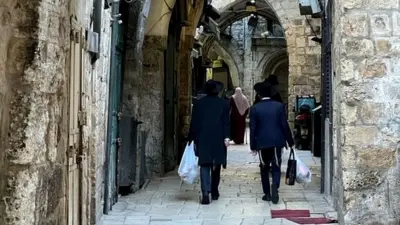We've updated our Privacy and Cookies Policy
We've made some important changes to our Privacy and Cookies Policy and we want you to know what this means for you and your data.
Church founded by St David pupil to hold final service
- By James McCarthy
- BBC News
Image source, Robin Drayton/Geograph
A church founded by a pupil of St David, the patron saint of Wales, is set to hold its final service due to dwindling congregations.
Believed to have been started in 583, St Madoc of Ferns in Haroldston West is closing 1,439 years after being used as a place of worship.
Church warden, Diana Thomas, said: "I"m devastated, I've been using the church for 40 years."
The hope now is for the Pembrokeshire church to become a community centre.
Madoc was born in 558 in Templeport, in Ireland's County Cavan, before he reached Wales as a follower of David, the patron saint of Wales.
Services in the parish are rotated around a number of churches which share the same vicar. Only two people attend the services which are held every few weeks.
Church warden, Diana Thomas, said: "As a place of worship it was started by St Madoc in 583, he was a follower of St David.
"He set up a little cell with the idea of going into the countryside and bringing people into the church.
"Obviously it would have been nothing like the building there now but just a little wooden building.
"Madoc finished up as Bishop of Ferns in Ireland."
Image source, David Mortimore
That title still exists in the Catholic Church but not the Church of Ireland.
Ms Thomas said: "I have had a lot of family connections with it. Marriages and funerals, that sort of thing.
"It's a real shame but things change and that is the position we are in."
As a church warden Ms Thomas helps look after the church.
"I can no longer carry on doing what I have been doing for any longer," she said.
"I'm getting older. I'm 80 years old for God's sake, and I feel it. I'm just unable to do it all the time and the other church warden feels the same way."
Image source, Family Photo
The wardens are volunteers who look after the church and prepare it for services.
Ms Thomas remembers when there were regularly 30 or 40 people attending services. The church can hold 50 worshippers.
"It was near enough a full church at that time, and we had a lot more services," she said.
"It was a flourishing little church but people have moved away and people die and new people are not coming in."
Because so many properties in Pembrokeshire are holiday homes there are not enough people to sustain the church Ms Thomas said.
The church is expected to have its last service at the end of July.
It is in the parish of Rev David Mortimore.
He said: "It's in a farming area where there are only 100 houses in the parish and some of them are holiday homes.
"So we only have two ladies who are getting elderly and are unable to keep going."
Image source, Deborah Tilley/Geograph
Rev Mortimore said there are historically a lot of churches in Pembrokeshire because of the farming communities it supported before the advent of mass tourism.
A meeting organised by the Havens History Group on 11 May resulted in a plan for the building to be taken over by a community group.
The history group's Shirley Norman who runs Littlehaven's Boathouse Gallery said about 30 attended.
She said: "We have 12 people who are definitely willing to help and who left their contact details.
"One lady from Broad Haven has offered to apply for funding because that is her full-time job."
A further meeting will be held on 8 June.
Ms Norman said: "Our immediate problem is that the electricity will be cut off at the end of June if we do not take action soon.
"We still hope the new group will have ideas about recruiting someone with building knowledge."
Who was St Madoc?
Image source, Basher Eyre/Geograph
Madoc is believed to have been born on an island in Brackley Lough, County Cavan, in 558.
As a young man his reputation as a holy man was growing and he decided to leave Ireland for Wales to study under David.
He became known as one of his three most faithful disciples and had a reputation as a miracle worker.
He later returned to Ireland and founded several monasteries. One of these was at Ferns, on land given to him by Brandubh, King of Leinster.
Here a synod was held, where in about 598 he was elected and consecrated bishop.
Madoc died on 31 January, 626.
Source: The Catholic Encyclopaedia
Top Stories
Features & Analysis
Most read
Content is not available







